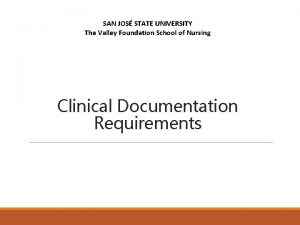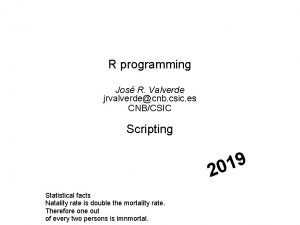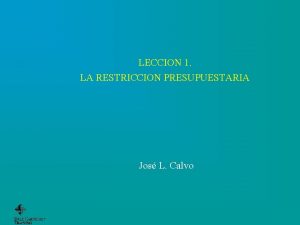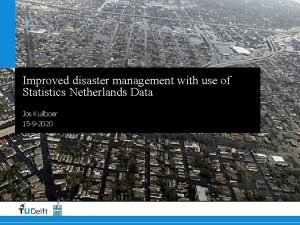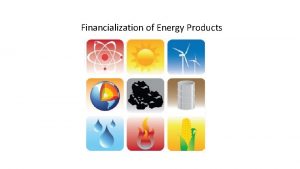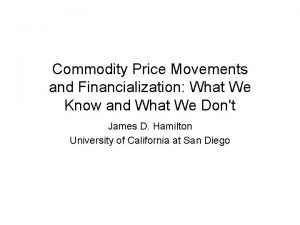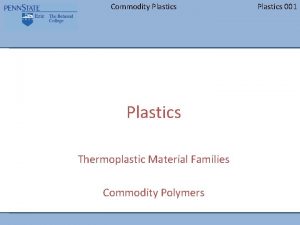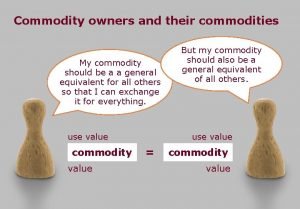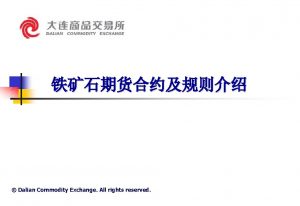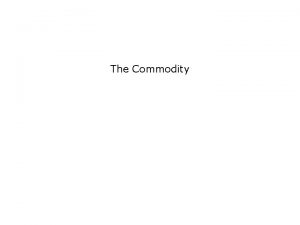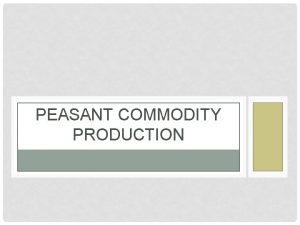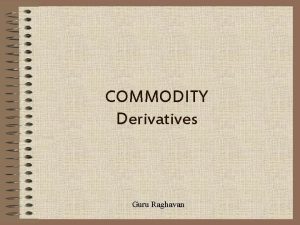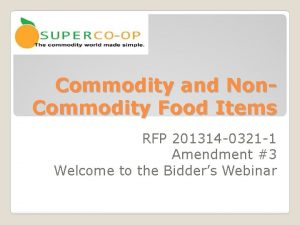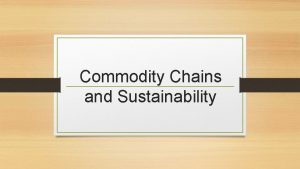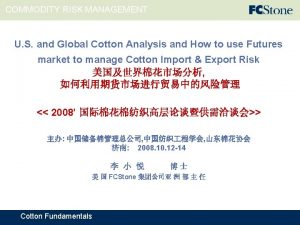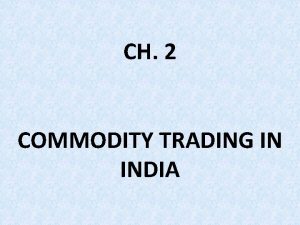Financialization of Commodity Markets Jos Antonio Murillo G20
























- Slides: 24

Financialization of Commodity Markets José Antonio Murillo G-20 Conference on Commodity Price Volatility September 13, 2011

Index 1 Introduction 2 Theory 3 Empirical Studies 4 Concluding Remarks 2

1. Introduction • Level and volatility of commodity prices have increased in recent years. • As a result of this situation, the G-20 created a study group to analyze the factors behind these phenomena. • Main conclusions of this report coordinated by Mr. Hiroshi Nakaso (G-20, 2011): ü The key factor behind this behavior is a change in fundamentals. ü A sharp increase in financialization of commodities has also been observed. The report reviews opposed studies regarding the impact of this event on commodity prices without arriving to a conclusion. 3

1. Introduction General Commodity Price Index in Real Terms (2002=100) Futures and Option Contracts Outstanding in Commodity Exchanges (Number of contracts in millions) Source: IMF. Source: Bank for International Settlements. 4

1. Introduction • What has been the impact of financialization on price levels and volatility? • Theory states that, by providing liquidity, financialization of commodities contributes to the efficient allocation of resources. Nonetheless, volatility could be exacerbated in the presence of certain market failures. • Empirical studies are not conclusive, some find weak evidence of financialization being a driver of observed price developments while others find no relation. • Yet, some voices argue for stricter trading regulations. 5

Index 1 Introduction 2 Theory 3 Empirical Studies 4 Concluding Remarks 6

2. Theory The participation of financial investors in commodity markets is expected to: ü Satisfy the hedging needs of market participants. ü Lower price volatility and add liquidity (Friedman, 1953; Hicks 1939; Kaldor, 1939; Keynes, 1930). ü Enable investors to further diversify their portfolios. ü Improve the quality of price signals (Fama, 1970, 1991). Ø Greater financialization fosters in the medium term the production of commodities. 7

2. Theory Potential market failures: • Market imbalances (G-20, 2011). ü Liquidity adds depth to the market. • Distortion of price signals (Black, 1986; De Long, et. al. , 1990; G-20, 2011; Kyle and Xiong, 2001; UNCTAD, 2011). ü Transparency and timely availability of information. Ø Deeper financialization limits the adverse effects of market failures. 8

2. Theory Theoretical conditions under which speculation could have an impact on commodity prices are (Hamilton, 2009): • Low price elasticity of demand. • For non-renewables, Hotelling principle. However, the same conditions exacerbate the impact of fundamentals on commodity prices. Hence, which is the culprit financialization or the low price elasticity of demand unresponsive supply? 9

2. Theory • Theory has not offered a compelling argument regarding the influence of financialization on prices. • The bottomline is that commodity markets are inherently volatile due to changes in inventories and fluctuating weather conditions. • On balance, the participation of financial investors in commodity markets contributes positively to the efficient allocation of resources. Ø Financialization of commodity markets fosters the efficient allocation of resources. 10

Index 1 Introduction 2 Theory 3 Empirical Studies 4 Concluding Remarks 11

3. Empirical Studies The main issues of the G-20 report on commodities empirical review are: ü Speculation “causes” changes in commodity prices. ü Futures markets lead changes in commodity markets. ü Speculation determines co-movements between futures and spot prices. ü Role of financial bubbles in commodity futures on commodity prices. 12

3. Empirical Studies 13

3. Empirical Studies 14

3. Empirical Studies 15

3. Empirical Studies Conceptual flaws: ü Several refer to the recent price increase period of 2007 -2008. ü Focus on specific commodities. ü Proxies for speculation are open to debate. ü Measuring financial bubbles with explosive components is nonconclusive. ü Studies based on few observations. 16

3. Empirical Studies Methodological flaws: ü Granger-causality tests are not conclusive for causation. ü Recursive testing over moving data-windows has low statistical power. ü Recursive augmented Dickey-Fuller test requires further study. ü Testing for non-stationarity is not appropriate to identify bubbles. 17

3. Empirical Studies Some considerations: • Given the ambiguity of empirical results and their methodological caveats, it is unclear if there are persistent effects of financialization on commodity prices (or vice versa). • As the G-20 report recognizes, still more research is needed in this area, which would greatly benefit from better data. • Additionally, methodological and conceptual misconceptions still need to be addressed. 18

Index 1 Introduction 2 Theory 3 Empirical Studies 4 Concluding Remarks 19

4. Concluding Remarks • Over-regulation on financial commodity markets leads to inefficiencies and negative welfare effects. • Deepening of financialization allows better risk-sharing and enhances better allocation of resources in commodity markets. • The challenge is to extend markets and facilitate the flow of information among participants, including regulators. • Policies should improve market transparency, data availability and timeliness. • The existence of these markets during this period of volatility has helped producers and consumers hedge against price fluctuations. 20

References Black, F. (1986), “Noise”, Journal of Finance, 41, 529 -543. Buyuksahin, B. and Robe, M. A. (2011), "Speculators, commodities and cross-market linkages", Available at SSRN: http: //ssrn. com/abstract=1707103. CFTC (2008), “Interim Report on Crude Oil. Interagency Task Force on Commodity Markets”. De Long, J. B. , Shleifer S. , Summers L. H. and Waldman R. J. (1990), “Noise Trader Risk in Financial Markets”, Journal of Political Economy, 98(4), 703 -738. Fama, E. F. (1970), “Efficient Capital Markets: A Review of Theory and Empirical Work”, Journal of Finance, 25, pp. 383 -417. ––––––– (1991), “Efficient Capital Markets: II”, Journal of Finance, 46 (5), pp. 1575 -1617. ––––––– (1998), “Market Efficiency, Long-Term Returns, and Behavioral Finance, ” Journal of Financial Economics, 49, pp. 283 -306. Friedman M. (1953), “Essays in Positive Economics”, Chicago Press. G-20 (2011), “Report to the G-20 Study Group on Commodities”, July 2011. 21

References Gilbert, C. L. (2010), "Speculative influence on commodity future prices 2006 -2008", UNCTD Discussion Paper 197. Hamilton, J. (2009), “Causes and Consequences of the Oil Shock of 2007 -08, ” NBER Working Paper 15002. Hart, O. D. and Kreps, D. M. (1986), “Price destabilizing speculation”, Political Economics, 94(5) pp. 927 -952. Hernández, M. and Torero, M. (2010), "Examining the dynamic relationship between spot and future prices of agricultural commodities", IFPRI Discussion Paper 00988. Hicks, J. R. (1939, 2 nd ed. 1946), “Value and Capital: An Inquiry into Some Fundamental Principles of Economic Theory”, Oxford: Clarendon Press. IFPRI (2009), “When speculation Matters”, IFRPI Issue Brief 57 February 2009. IMF (2008), “Global Stability Report. Financial Stress and Deleveraging Macro-Financial Implications and Policy”, Annex 1. 2. October 2008. Irwin, S. H. and Sanders, D. R. (2010), “The impact of Index and Swap Funds on Commodity Futures Markets: Preliminary Results”, OECD Food, Agriculture and Fisheries Working Paper No. 27. 22

References Irwin, S. H. , Sanders, D. R. , and Merrin, R. P. (2009), “Devil or Angel? The Role of Speculation in the Recent Commodity Boom (and bust)”. Journal of Agricultural Applied Economics, 41(2): 393 -402. Kaldor, N. (1939), “Speculation and Economic Stability”, The Review of Economic Studies, 7(1), pp. 1 -27. Kawamoto, T. , Kimura, T. , Morishita, K. and Higashi, M. (2011), "What Has Caused the Surge in Global Commodity Prices and Strengthened Cross-Market Linkage? ", Bank of Japan Working Paper 11 -E-3. Keynes , J. M. (1930), “A Treatise on Money”, Vol. II: The Applied Theory of Money. London: Macmillan & Co. Kilian, L. and Hicks, B. (2009), “Did Unexpectedly Strong Economic Growth Cause the Oil Price Shock of 2003 -2008? ”. Korniotis, M. G. (2009), “Does Speculation Affect Spot Price Levels? The Case of Metals with and without Futures Markets”, Finance and Economics Discussion Series. Divisions of Research & Statistics and Monetary Affairs. Federal Reserve Board, Washington, D. C. Kyle A. S and Xiong W. (2001), “Contagion as Wealth Effect”, Journal of Finance 56(4), 1401 -1440 23

References Lütkepohl, H. (2005), New Introduction to Multiple Time Series Analysis, Berlin, Springer. Malkiel B. G. (2003), “The Efficient Market Hypothesis and its Critics”, Journal of Economic Perspectives, 17(1), pp. 59 -82. Mayer, J. (2009), "The growing interdependence between financial and commodity markets", UNCTD Discussion Paper 195. Mayer, J. (2011), "Price formation in financialized commodity markets: The role of information", UNCTAD. Pearl, J. (2000), “Causality”, New York, Cambridge University Press. Phillips, P. C. B. , Wu, Y. and Yu, J. (2011), “Explosive behavior in the 1990 s Nasdaq: When did exuberance escalate asset values? ”, International Economic Review, 52: 201226. Singleton (2011), "Investor flows and the 2008 boom-bust in oil prices", Available at SSRN: http: //ssrn. com/abstract=1793449. Tang, K. and Xiong, W. (2010), "Index investments and financialization of commodities", NBER Working Paper 16385. 24
 Murillo pintor
Murillo pintor Características de una entrevista
Características de una entrevista The return of the prodigal son murillo
The return of the prodigal son murillo Virgen de la leche escuela cusqueña
Virgen de la leche escuela cusqueña Murillo joven mendigo
Murillo joven mendigo Ana luz esquinas murillo
Ana luz esquinas murillo El regreso del hijo prodigo murillo
El regreso del hijo prodigo murillo Cláudio murillo cavalcanti
Cláudio murillo cavalcanti Celebrating dr. ildaura murillo-rohde
Celebrating dr. ildaura murillo-rohde Johnny villalobos murillo
Johnny villalobos murillo Bartolomego estebana murillo syn marnotrawny
Bartolomego estebana murillo syn marnotrawny Elvis murillo xxx
Elvis murillo xxx Još hrvatska ni propala tekst
Još hrvatska ni propala tekst Tipos de jos
Tipos de jos San jos state university
San jos state university Jos r
Jos r Jos verlinden
Jos verlinden Jos t
Jos t Corecteza greselile din propozitiile de mai jos
Corecteza greselile din propozitiile de mai jos L calvo
L calvo Luis jos gallego
Luis jos gallego Budnica još hrvatska ni propala
Budnica još hrvatska ni propala Jos i
Jos i Jos kuilboer
Jos kuilboer Exemple de boli cromozomiale
Exemple de boli cromozomiale














